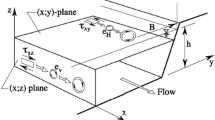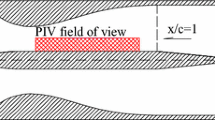Abstract
In this work, we propose a new detector function based on wavelet transform to discriminate between turbulent and non-turbulent regions in an intermittent velocity signal. The traditional detector functions based on first or second derivative of velocity signal, which are commonly used in intermittency calculation schemes, show large fluctuations within turbulent parts of the signal and require averaging over a certain “smoothing period” to remove the fake dropouts, introducing subjectivity in calculating intermittency. The new detector function proposed here is obtained by averaging the “pre-multiplied wavelet energy” over the entire frequency range, which can be interpreted as wavelet energy contained in the first derivative of the velocity signal. We demonstrate the effectiveness of our detector within the framework of the widely used method by Hedley and Keffer (J Fluid Mech 64:625, 1974), for a range of velocity signals representing the different stages of roughness-induced transition. We show that the wavelet detector is much smoother than the double-derivative-based detector of Hedley and Keffer, and at the same time has a good discriminatory property (due to pre-multiplication by frequency). This makes the choice of the smoothing period unnecessary and removes the subjectivity associated with it. The wavelet detector function works equally well in detecting the edge intermittency of a canonical turbulent boundary layer, thereby highlighting its generality. The performance of the proposed detector to calculate edge intermittency is compared with a recent energy-based method by Chauhan et al. (J Fluid Mech 742:119, 2014), showing a favorable match. Our detector can, in principle, be used with any of the methods used for specifying threshold for obtaining an indicator function.


















Similar content being viewed by others
Data availability
Data are available from the corresponding author (SSD) on request.
References
Anand A, Diwan SS (2020) Time-frequency analysis for two cases of boundary-layer transition induced by random distributed roughness. Exp Fluids 61:60
Bruun HH (1995) Hot-wire anemometry. Oxford University Press, Oxford
Camussi R, Guj G (1997) Orthonormal wavelet decomposition of turbulent flows: intermittency and coherent structures. J Fluid Mech 348:177–199
Canepa E, Ubaldi M, Zunino P (2002) Experiences in the application of intermittency detection techniques to hot-film signals in transitional boundary layers. The 16th symposium on measuring techniques in transonic and supersonic flow in cascades and turbomachines, pp 2077–2085. https://api.semanticscholar.org/CorpusID:59474772
Chauhan K, Philip J, de Silva CM, Hutchins N, Marusic I (2014) The turbulent/non-turbulent interface and entrainment in a boundary layer. J Fluid Mech 742:119–151
Cohen L (1995) Time-frequency analysis. Prentice-Hall PTR, London
Durbin PA (2017) Perspectives on the phenomenology and modeling of boundary layer transition. Flow Turbul Combust 99(1):1–23
Emmons HW (1951) The laminar-turbulent transition in a boundary layer-part I. J Aero Sci 18(7):490–498
Farge M (1992) Wavelet transforms and their applications to turbulence. Ann Rev Fluid Mech 24(1):395–457
Fransson J, Matsubara M, Alfredsson P (2005) Transition induced by free-stream turbulence. J Fluid Mech 527:1–25
Frisch U (1995) Turbulence: The legacy of A.N. Kolmogorov. Cambridge University Press, Cambridge
Hedley TB, Keffer JF (1974a) Some turbulent/non-turbulent properties of the outer intermittent region of a boundary layer. J Fluid Mech 64(4):645–678
Hedley TB, Keffer JF (1974b) Turbulent/non-turbulent decisions in an intermittent flow. J Fluid Mech 64(4):625–644
Jahanmiri M (2011) Turbulent-nonturbulent interface detection methods in transitional flows, Chalmers University of Technology, Technical report 2011(11):1–17
Kuan C, Wang T (1990) Investigation of the intermittent behavior of transitional boundary layer using a conditional averaging technique. Exp Thermal Fluid Sci 3(2):157–173
Kovasznay L, Kibens V, Blackwelder R (1970) Large-scale motion in the intermittent region of a turbulent boundary layer. J Fluid Mech 41(2):283–325
Mamidala S, Weingärtner A, Fransson J (2022) A comparative study of experiments with numerical simulations of free-stream turbulence transition. J Fluid Mech 951:A46
Mancinelli M, Di Marco A, Camussi R (2017) Multivariate and conditioned statistics of velocity and wall pressure fluctuations induced by a jet interacting with a flat plate. J Fluid Mech 823:134–165
Matsubara M, Alfredsson PH, Westin KJA (1998) Boundary layer transition at high levels of free stream turbulence. In: Proceedings of the ASME 1998 international gas turbine and aeroengine congress and exhibition. Volume 1: Turbomachinery, V001T01A063, https://doi.org/10.1115/98-GT-248
Narasimha R (1957) On the distribution of intermittency in the transition region of a boundary layer. J Aero Sci 24:711–712
Narasimha R (1985) The laminar-turbulent transition zone in the boundary layer. Prog Aerosp Sci 22(1):29–80
Nolan KP, Zaki TA (2013) Conditional sampling of transitional boundary layers in pressure gradients. J Fluid Mech 728:306–339
Otsu N (1979) A threshold selection method from gray-level histograms. IEEE Trans Syst Man Cybern 9(1):62–66
Philip J, Meneveau C, de Silva CM, Marusic I (2014) Multiscale analysis of fluxes at the turbulent/non-turbulent interface in high reynolds number boundary layers. Phys Fluids 26(1):015105
Pomeaus Y, Manneville P (1980) Intermittent transition to turbulence in dissipative dynamical systems. Commun Math Phys 74:189–197
Ruppert-Felsot J, Farge M, Petitjeans P (2009) Wavelet tools to study intermittency: application to vortex bursting. J Fluid Mech 636:427–453
Samson A, Naicker K, Diwan SS (2021) Instability mechanisms and intermittency distribution in adverse pressure gradient attached and separated boundary layers. Phys Fluids 33(9):094106
Semin NV, Golub VV, Elsinga G, Westerweel J (2011) Laminar superlayer in a turbulent boundary layer. Tech Phys Lett 37:1154–1157
Simoni D, Lengani D, Guida R (2016) A wavelet-based intermittency detection technique from piv investigations in transitional boundary layers. Exp Fluids 57:145
The MathWorks, Inc. 2022. Wavelet toolbox. https://in.mathworks.com/help/wavelet/ref/cwt.html
Torrence C, Compo GP (1998) A practical guide to wavelet analysis. Bull Amer Meteorol Soc 79(1):61–78
Tropea C, Yarin AL, Foss JF et al (2007) Springer handbook of experimental fluid mechanics. Springer
Tyagi A, Kumar C, Diwan S (2022) On the structure of a turbulent boundary layer perturbed by a large-eddy break-up device. 12th international symposium on turbulence and shear flow phenomena. http://www.tsfp-conference.org/proceedings/proceedings-of-tsfp-12-2022-osaka.html
Veerasamy D, Atkin C (2020) A rational method for determining intermittency in the transitional boundary layer. Exp Fluids 61:11
Volino RJ (2005) An investigation of the scales in transitional boundary layers under high free-stream turbulence conditions. Exp Fluids 38:516–533
Zhang W, Liu P, Guo H (2018) Conditional sampling and wavelet analysis in early stage of step-generated transition. AIAA J 56(6):2471–2477
Acknowledgements
We thank the reviewers for their critical comments which have helped improve the quality of the paper.
Funding
We acknowledge financial support from Science and Engineering Research Board (SERB), India (Grant No.: ECR/2018/002417) toward conducting experiments on the turbulent boundary layer.
Author information
Authors and Affiliations
Contributions
SSD conceived of the study. SD and AA carried out the data processing and analysis. SD prepared the figures. SD, AA and SSD wrote the manuscript. SSD supervised the work.
Corresponding author
Ethics declarations
Conflict of interest
The authors declare no competing interests.
Ethical approval
Not applicable.
Additional information
Publisher's Note
Springer Nature remains neutral with regard to jurisdictional claims in published maps and institutional affiliations.
Appendices
Appendix A
In this appendix, a comparison is made between the detector functions obtained by various mother wavelets. Three wavelets namely, Morse, Morlet and Bump, have been selected for the current study as shown in Fig. 19. The corresponding detector functions are shown in Fig. 20. Further details about the wavelets can be found in the documentation of “cwt" command in MATLAB (The MathWorks 2022). As can be seen from Fig. 20, all three detector functions are smooth in nature and act as an envelope over the HK-detector. The Bump wavelet does not perform very well in the laminar intervals as it shows relatively high values there, limiting the quality of discrimination between laminar/turbulent regions. The detectors for Morse and Morlet wavelets are close to each other with the latter showing lower values within laminar intervals thereby giving a slightly better contrast between laminar and turbulent regions near the leading and trailing edges of the spots. We therefore choose Morlet wavelet for the present analysis. Note that the Morlet wavelet has been used previously by researchers for detecting turbulent spots (Zhang et al. 2018; Anand and Diwan 2020), supporting our choice of this wavelet. A more extensive analysis on the effect of mother wavelet on the detector function is out of the scope of the present study.
a Mid-Transitional velocity signal (scaled from 0 to 1) vs. time (s). b Detector function by HK-method and by the three mother wavelets, namely Morlet, Morse and Bump (Fig. 19)
Appendix B
The wavelet transform of the velocity derivative at a fixed spatial point, \(\frac{du}{dt}\), is given as (Farge 1992).
where
This gives
where \(\Omega _c = (\omega _c^2 + \sqrt{2 + \omega _c^2 })/4 \pi\) from Eq. 5. The integral in Eq. B4 represents wavelet transform of u(t) using the derivative of Morlet wavelet given in Eq. B3. Figure 21 shows a comparison between \(\psi\) and \(\phi =\frac{d\psi }{dt}\) for \(t' =0\) and \(a=1\). As can be seen, \(\phi\) is shifted in phase w.r.t. \(\psi\) and shows higher magnitude than \(\psi\). However, the qualitative behavior and the temporal “support” of both the wavelets are similar. This is further seen by a comparison of the scaled envelope between \(\phi\) and \(\psi\), plotted in Fig. 22, which shows an exact match of the two scaled envelopes. Since in this work we are concerned with the square magnitudes of wavelet coefficients, one can expect that the wavelet transform w.r.t. \(\phi\) will cause a proportionate increase in the square magnitudes of wavelet coefficients as compared to the transform w.r.t. \(\psi\), i.e.
where
Eq. B5 in conjunction with Eq. B6 gives
where \(C_w\) is the wavelet coefficient in L1-norm (see Sect. 4). Thus the pre-multiplied wavelet energy \((\text {PMWE}=fC_w^2[u])\) used here to define detector function has a flavor of the square magnitude of the wavelet coefficients of the velocity derivative. It thus signifies the energy contained in the velocity derivative rather than the velocity itself. In this sense, the present detector function is distinct from that proposed by Chauhan et al. (2014) who use kinetic energy of fluctuations to define their detector function.
Rights and permissions
Springer Nature or its licensor (e.g. a society or other partner) holds exclusive rights to this article under a publishing agreement with the author(s) or other rightsholder(s); author self-archiving of the accepted manuscript version of this article is solely governed by the terms of such publishing agreement and applicable law.
About this article
Cite this article
De, S., Anand, A. & Diwan, S.S. A wavelet-based detector function for characterizing intermittent velocity signals. Exp Fluids 64, 180 (2023). https://doi.org/10.1007/s00348-023-03714-8
Received:
Revised:
Accepted:
Published:
DOI: https://doi.org/10.1007/s00348-023-03714-8








